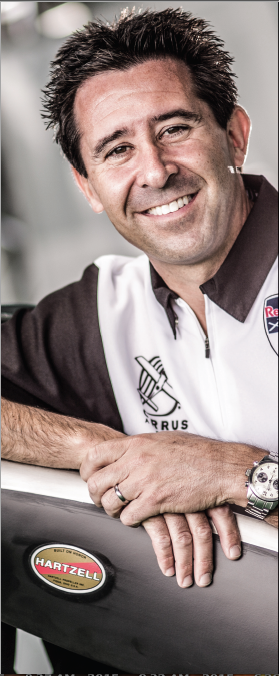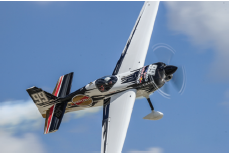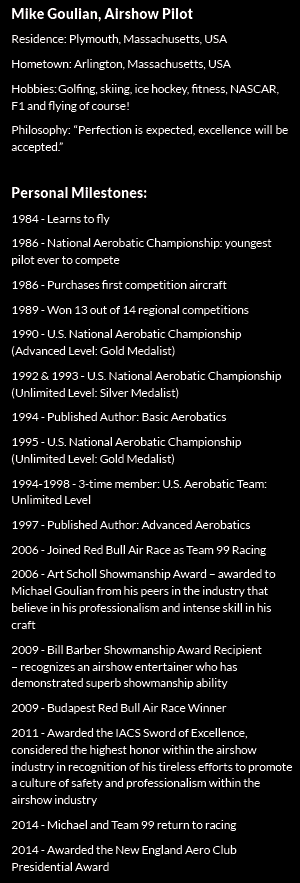
HARTZELL: How long have you been flying and how long have you been an aerobatic pilot?
MICHAEL GOULIAN: I started flying in 1985. So I guess 30 years ago? Believe it or not I started flying aerobatics as a student pilot. So probably 28 out of those 30 years I have been flying aerobatics or performing. You never really perfect it, but I still love it as much today as when I started.
HARTZELL: Starting that young sounds pretty uncommon.
MG: Yeah. You know, I grew up in my family’s aviation business so I was exposed to aviation at a young age. At about 14, my dad brought me to the airport, and I started working there. He wanted me to know what it was like to make a hard earned dollar and learn the value of money.
HARTZELL: Your father was also a pilot then?
MG: Yes, my dad learned to fly when he was just 15. He started our flight school, Executive Flyers Aviation in 1964. We’re still operating today out of the same facility where we started more than 50 years ago. It’s located just west of Boston at Hanscom Field.
HARTZELL: What did he say when you told him you wanted to try aerobatics?
MG: Well, aerobatics, when he was a kid, were re-ally flown in planes that were converted World War II planes or were trainers of the day: Stearmans, Chipmunks and Taylorcrafts, airplanes that were modified to fly aerobatics. They were not specific aerobatic aircraft like we have today.
His initial reaction was a lot of fear and trepidation be-cause I don’t think he really knew what my motivation was. When you’re playing golf or ice hockey, you’re always competing. Aerobatics was something I could measure myself against as a pilot. I think he was pretty nervous in the beginning, but he saw how organized aerobatics had become in the United States. We have never had a fatality in a U.S. competition in the United States run by the International Aerobatic Club. It is a safe thing to do, and it is a great way to learn to fly well.
HARTZELL: That makes a lot of rational sense. But, when you’re dealing with your son’s safety. I wonder what you actually said to him to get the go-ahead.
MG: You know; I bugged him. I just drove him crazy. He actually allowed me to learn aerobatics, but when I wanted to buy my own airplane, he just said flat-out, “No.” And it wasn’t an expensive airplane, just a little
Pitts S1-C. I had earned some money so I could make the down payment and get the rest on a loan. I just drove him and my mom crazy until finally they just said, “Okay, okay!”
It took quite a long time. Maybe that’s be-cause he was nervous about his kid, but he never showed it that way. My dad gave me a lot of leeway. Growing up as a kid I never had a curfew, I just kind of knew what the limit should be, and as long as I stayed within the bounds of those limits and didn’t go outside of them, he was fine. It was the same with flying. I’m sure he was really nervous, but I think he had a lot of faith in my skill, in my attitude towards it, in my professionalism. And, I think he realized pretty early on that he wasn’t going to change my mind. When I won the nationals in 1995, I think he was even more excited than I was.
HARTZELL: He sounds like an incredible guy. Actually, you sound like you were a pretty incredible 14-year-old.
MG: Probably so! I bet. When I was beg-ging for an airplane by 17, my parents were probably about ready to kill me.
HARTZELL: Do you remember what it was like to fly the Pitts?
MG: I remember the first flight like it was yesterday. We hired my aerobatic instructor to go get it, because I am not sure I could have taken it home on my own. This was back in the days before LORANs were common and before GPSs. Aerobatic airplanes didn’t even really have starters. They were eliminated for weight.
I had about six hours in a two-seat Pitts before I got in my own, but the S1-C was an open cockpit airplane. I can remember taking off and, never having been in an open cockpit airplane before, it just felt so surreal. As a 17-year-old kid, that was pretty awesome.
HARTZELL: Fast forward a little bit. How does getting in the cockpit of your Air Race plane compare?
MG: That’s a great question. You know, the Air Race happens on a world stage. You get comfortable with having television cameras follow you around all day, but you also know that your performance is going to be watched around the world. There is a lot of pressure to perform well. Today, being sort of a veteran in this game, the nervousness and anxiety is more internal. It’s pressure that you put on yourself.
All 14 pilots are just really Type A “go-get-em” people, and there is not a weak pilot in the group. You know that if you are going to do well, you are going to beat some seriously good pilots in some seriously good airplanes.
HARTZELL: What do you think about when you are going through the course? Do you even have time to think?
MG: When it’s race day, it is game day. From the time you walk into the airport it’s just different. It’s all quiet. Everybody knows that this is where it’s at. We have worked for 10 days in a foreign country to be where we are right now, in the moment.
My job is to try to take the pressure and just get rid of it. It’s just you and the elements, and you and your nerves. My job is to fly as well in the race as I do in practice, and that is hard work. Your physical preparation in the gym is one thing. Your physical preparation in the plane is another. But your mental game has to be as strong as the physical game.
HARTZELL: Not to play armchair sports psychologist, but it’s interesting that you put that pressure on yourself and it is your responsibility to take it off.
MG: Yes, for sure. You have to recognize it and find a way for it to roll off your back.
HARTZELL: That’s a challenge a lot of people can relate to; getting out of your own way so you can find success.
MG: Absolutely. Not worrying about success, and just letting success come to you is the most important thing. When you’re doing something really well you look back on it and say, “Ah, that was really easy.”
“In the zone,” that’s kind of a buzzword, but it’s true. It’s being able to slow down time, make minute adjustments and think ahead of the machine. All those things allow you to perform really well and be calm in mind and body both — all while being 35 feet off the water, doing 200 miles an hour and trying to fly between pylons.
HARTZELL: Do you remember the first time you really felt “in the zone”?
 MG: Yeah, I have to say that I have probably only had those moments a few times in my career. Sometimes they lasted for a while, and sometimes they were fleeting. There’s definitely two. Well, actually there’s three times.
MG: Yeah, I have to say that I have probably only had those moments a few times in my career. Sometimes they lasted for a while, and sometimes they were fleeting. There’s definitely two. Well, actually there’s three times.
I flew a freestyle flight in the World Aero-batic Championship in 1998 that was just magic. I don’t know why. It was the time of day. It was the wind. The flight just scored really, really well because it was about as good as I could do. It was a combination of good practice, good training and the right circumstances. There was one year at Oshkosh where I did an airshow where I came out thinking, “You know what? I’m not sure I could have done any better than that.” It’s one of those things where you get in such a trance that you almost have to look back and say to yourself, “Did I do that group of maneuvers? Yeah. Yeah, I did.” But you are in such a trance and it just happens. It was the same thing when I won the Air Race in Budapest in 2009. I was on my own course, and I was doing my own thing. I didn’t care what anybody else was doing. I just went out there and laid it down, and it worked.
Those are three instances where I was in the zone, and they are so memorable. I mean, they happened years apart, but they are so fleeting. I think if you were to ask any high-level athlete, they probably only see that very occasionally as well. It is so hard to get there.
HARTZELL: That’s the key to those really memorable perfect runs, but you aren’t able to get there all the time. What does it take to do what you do week after week without be-ing able to rely on being “in the zone”?
MG: You have to be excellent all the time. You can have a bad day, but your bad day in airshow flying or in air racing should still be excellent. You should still be better than 98% of the people on the planet. When you reach your level of being “in the zone,” then it’s exceptional. A golfer doesn’t win a golf tournament every time they play. They might win two or three or five in their career, but…
HARTZELL: But you still have to be better than par on a regular basis just to be able to show up and play.
MG: Exactly. Exactly. So, if par is average and today you were under par, that’s awe-some. And if you are more under par than everybody else, that’s amazing. When you look at the winner of an Air Race or a World Aerobatic Championship, you can say, “You know what? That person was the best this week.” Everything they did was great. They started great. They ended great. There is always one person who stands out from the rest because it was just their week. I guess that’s why we still compete. Trying to reach that elite level is so difficult.
HARTZELL: Following that idea of a “need” to compete, what were your thoughts when you heard the Red Bull Air Race World Championship was coming back?
 MG: I was excited. I missed the race a lot. I missed the flying most of all, but I also missed the camaraderie of the people, and I missed the teams themselves.
MG: I was excited. I missed the race a lot. I missed the flying most of all, but I also missed the camaraderie of the people, and I missed the teams themselves.
It is a sport where everybody is trying to be the best, and — let’s face it — in our sport if you screw up you could die. You can’t say that in golf. You can’t say that in tennis. But there is a level of seriousness about that, and so the people involved are all A-players. That’s the coolest part about it; everybody is rockin’ it to be the best. It’s a great atmosphere to live in. I’m lucky to be in that atmosphere. I get to be around so many people that strive for excellence all the time. That for me is really inspiring.
HARTZELL: Could you try to paint a picture of what it is like to be there on race day, going through that course at 200 miles per hour?
MG: The first thing is that we’re always a long way from home. We’re racing in Ja-pan, we raced in Abu Dhabi. We’re 7, 8 or 9 thousand miles away from home, and it has been a tremendously long week. I must say that I’m always a little homesick towards the end of a race week.
You have to dig really deep. Even though you have been eating foreign food and you might not be sleeping well, today is the day you have to be the best that you can be. Then you put the flight suit on and it’s go time.
An electronic board shows your start time, and you start to work backwards: I’m gonna get in the airplane by 43 past the hour. I’m gonna have my seatbelts done by 48 past the hour. They are gonna push me out at 50. I’m gonna start the engine at 56. I’m gonna be in the air at 08, and on the track at 12. You start to think and know those kinds of numbers. You put the helmet on and your earplugs in, then you know, “Now it is game time. Now I have got to perform.”
You practice doing the same thing every time, so it feels like a routine. It might be practice, it might be qualifying or it might be a race, but you have to do the same thing every single time. You might have heard other athletes say “wash, rinse, re-peat.” You just get in the game and you go do it. Then you take off.
Even though the airplane is super loud, you don’t hear the noise. Even though it vibrates and shakes a lot, you don’t feel the vibration. You have got a job to do and it’s just getting the machine to do it. When you get out there in the holding area, you pull a bunch of G’s to get your body ready for what it will experience. Then it’s just about a minute-and-a-half of trying to fly absolutely as smooth as you can on a perfect line to make that thing go through the track as fast as possible. It’s over before it starts, but while it’s going on it seems like it takes forever.
HARTZELL: What’s the first thing that goes through your head after you touch down on the runway?
MG: It’s either one of two things. I have either operated to my expectations or I haven’t. If I have flown the race to my expectations, whether I won or lost, I’m satisfied with that. If I don’t, then I’m mad at myself. When you have a lot of experience and you make a mistake that you shouldn’t make, it wears on you. Like everybody, you feel emotion.
Either way you have to be professional at all times. You aren’t a champion because you won. You’re a champion because you tried, because you never give up and because you have faith in yourself and your team. You don’t become a champion in one day, you be-come a champion over decades. To me, champions are people who think like champions. They try to be a champion, they put the effort in, and that’s as hard as being a champion.
When I exhibit that over a race weekend or over a season, that is what makes me happy.
HARTZELL: This sort of came full circle. You said it’s your responsibility to take the pressure on yourself, and it seems like the emotional outcome you feel at the end is the same thing that makes you the right guy for the job.
MG: Right? I hope so.
HARTZELL: One last question. This is a yearly magazine, so what kind of message would you like to send to yourself one year from now? What’s your wish for the Michael Goulian of 2016?
MG: Try to make 2016 better than 2015. Try to learn from your mistakes in ‘15 and correct them for ‘16 so you can be a better person in the next year.